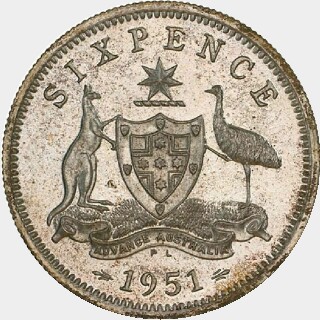



?
In 1951 the Royal

The 1951-PL
This was the first time that the London branch had produced sixpence pieces for Australia since 1914. They became involved in order to assist the Melbourne Mint in correcting a major change shortage that was being felt around Australia. The reasons for this shortage are difficult to untangle however one key reason seems to have been the previous years federal and state budgets which raised the prices of many services by one or two pence. These increases created a number of 'split prices' meaning that no one coin was able to pay for the good or service and as a result multiple coins were required to both pay for goods and to then provide change. For example, in Melbourne some tram fares were raised to five pence which required an awkward combination of pieces to get exactly, or for conductors to carry substantial quantities of change
These issues fueled debate around altering the Australian Pound. In a letter to the editor in the Sydney Morning Herald one man proposed reintroducing the 4 pence 'groat'. He argued that shortages and confusion could be resolved as with a single groat one could "...buy one tram or bus section ticket... thus helping conductors in the giving of change for amounts involving odd pennies." (The Sydney Morning Herald, 1951) However temporary solutions like this were dwarfed by arguments for the introduction of a decimal currency. In the same year a full page article in the Sydney newspaper 'The Sun' was headlined "Decimals might lighten our lives" Although the decimalised Australian dollar wasn't introduced until 1966 the responses to the coin shortage of 1951 illustrate a growing national desire for currency reform.
Find out what dealers are paying with a subscription.
Subscribe now!Find out what coins have actually sold for and where with a Standard/Professional subscription.
Subscribe now!